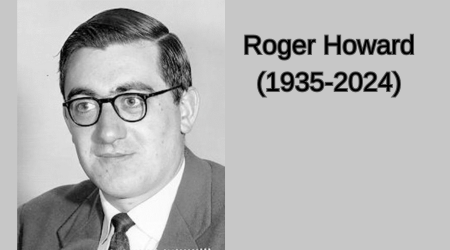Remembering Roger Howard (1935-2024)

The Department of Physics and Astronomy (PHAS) fondly remembers Roger Howard, a distinguished theoretical physicist and an early faculty member whose contributions were integral to the department's development.
Roger was born in England in 1935 in Robin Hood’s Nottingham region. He joined the UBC Physics Department in 1959 as a condensed matter theorist.
Roger's research interests evolved, leading him to the realm of subatomic physics. In the 1980s, he joined forces with Bruce White and Dave Axen on the ASTERIX experiment at CERN, where he explored into the computational aspects of particle physics.
Roger’s collaboration with Axen and Randy Sobie in the 1990s resulted in the formation of the OPAL UBC group. This team played a crucial role in the Canadian OPAL experiment at CERN, where Roger worked mainly on Monte Carlo simulations and developing computational tools. His work extended beyond OPAL to the GÉANT project—a high-capacity network developed at CERN to support national research and education networking (NREN) across Europe. GÉANT, widely used for particle tracking and simulations, is a significant tool for the particle physics and medical physics communities.
Roger and his wife, Betty Howard—UBC’s first female physics faculty member—were well-known among colleagues for their frequent summer visits to CERN, which they attended almost every year from 1994 to 2001.
At UBC, Roger was renowned for his dedication to teaching, particularly his enthusiasm for instructing PHYS 170, a course for first-year engineering students. He retired as an associate professor at the start of 2000.
Roger Howard passed away just shy of his 89th birthday, leaving behind a lasting impact on the field of physics and the UBC community. His contributions to theoretical physics and his passion for education are fondly remembered by all who had the privilege of working with him.
Learn More:
- What is the OPAL Experiment: CERN | (Omni-Purpose Apparatus at LEP): one of four large detectors on the Large electron-Positron collider (LEP)
- More about OPAL
- Beginner's Guide to OPAL by PHAS faculty Janis McKenna
- What is the ASTERIX spectrometer project: CERN | used to study the formation and ground state of the pp atom and exclusive final states of pp annihilation
- What is GÉANT impact: CERN
- GEANT4: Key Facts | CERN Acceleration Science
- Phas faculty Betty Howard: 100 Years of Physics at UBC – Betty Howard (1923-2003)
- PHAS faculty Bruce White and Dave Axen